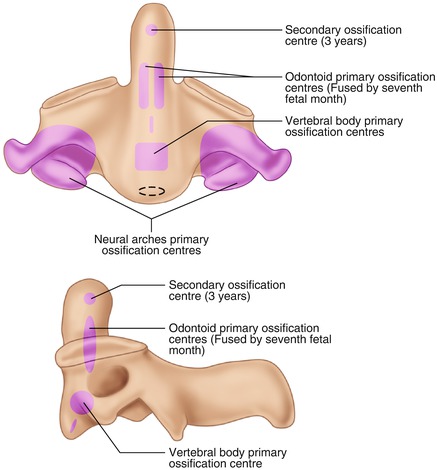Child
Adult
Multiple level INJ
Less common
Common
Structure injured
Ligaments/soft tissues
Bone
Upper C-spine (%)
70
15
Spinal cord INJ (%)
10
30
SCIWORA (% of SCI)
16
7
Thoracolumbar spinal injuries in children are less common, but within this group they are more common in adolescent children than those younger than 10 years. They also commonly involve multiple levels (16% and often at non adjacent level) due to the elastic intervertebral discs, which distribute forces across multiple levels.
4.3 Anatomy
To be confident in assessing paediatric spines clinically and radiologically, remember the unique ossification patterns of the paediatric spine.
4.3.1 Atlas (C1)
Three primary ossification centres:
Left and right neural arches (ossified at birth).
Vertebral body (ossifies at 1 year).
Fusion:
Atlas body and neural arches fuse at 7 years.
Spinous processes (neural arch) fuse at 3 years.
4.3.2 Axis (C2)
Four primary ossification centres at birth (Fig. 4.1):
Two odontoid ossification centres fuse in the midline by the 7th foetal month to form one at birth.
Vertebral body centre.
Two neural arches.

Figure 4.1
Ossification centres of odontoid. 1 Secondary ossification centre of odontoid (approximately 3 years), 2 Primary fusion centre of odontoid, 3 Primary ossification centre of vertebral body, 4 Primary ossification centre of of neural arch, 5 Secondary ossification centre of odontoid (approximately 3 years), 6 Primary fusion centre of odontoid, 7 Primary ossification centre of vertebral body
Secondary ossification centre at the tip of the odontoid appears at 3 years.
Inferior epiphyseal ring ossifies at puberty.
Fusion:
Spinous processes fuse at 3 years.
Axis body and neural arches fuse at 6 years.
Axis body and odontoid fuse at 6 years (often visible until age 12).
Secondary ossification centre of the odontoid fuses by 25 years, as does the ossification of the inferior epiphyseal ring.
4.3.3 C3-C7
Five ossification centres at birth:
Vertebral body.
Two neural arches.
Two transverse processes.
Fusion:
Spinous processes fuse by 3 years.
Transverse processes fuse to the vertebral body by 6 years.
The vertebral body fuses to the neural arches by 6 years.
Bifid processes appear at puberty and fuse by age 25.
Superior and inferior epiphyseal rings fuse by age 25.
4.3.4 Thoracic and Lumbar Spine
Adult characteristics and size are present by the age of 10, with similar radiographic examination, except for the open epiphyses.
Thoracic and lumbar spine ossify and fuse in a similar manner.
4.4 Diagnosis
4.4.1 Imaging
Cervical spine X-rays are not necessary to exclude an injury if the patient:
Is alert and conversant.
Has no neurological deficit.
Has no cervical tenderness.
Has no painful distracting injury.
Is not intoxicated.
If the patient does not fall into this bracket, then AP and lateral views are all that are required, as an odontoid view does not aid in making the diagnosis under age 8, and is very difficult to obtain.
Stay updated, free articles. Join our Telegram channel

Full access? Get Clinical Tree








